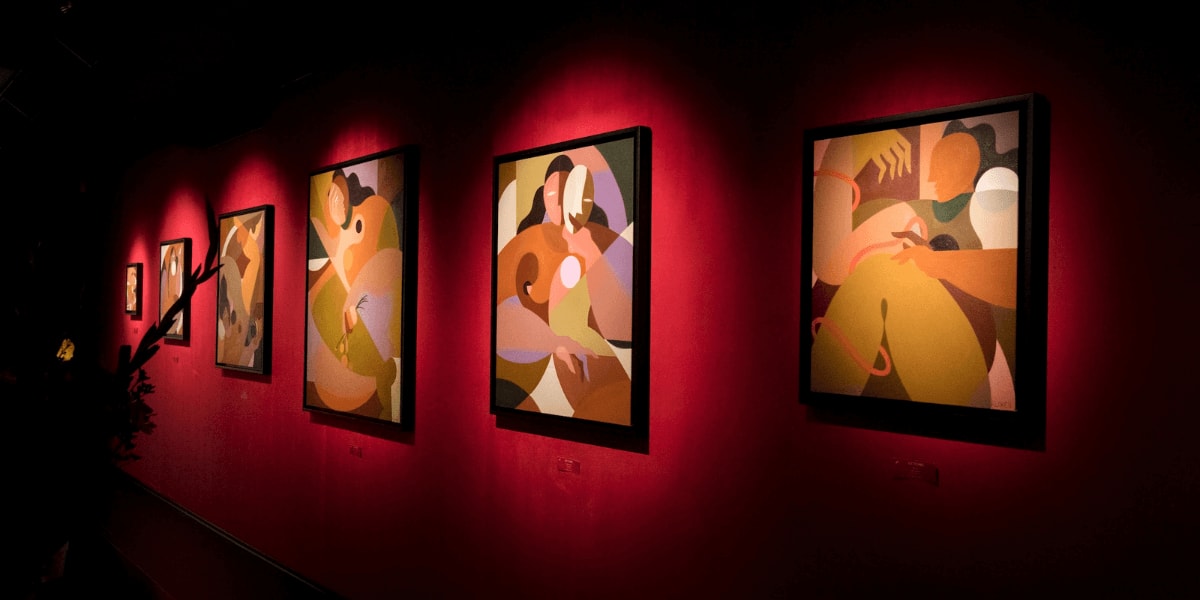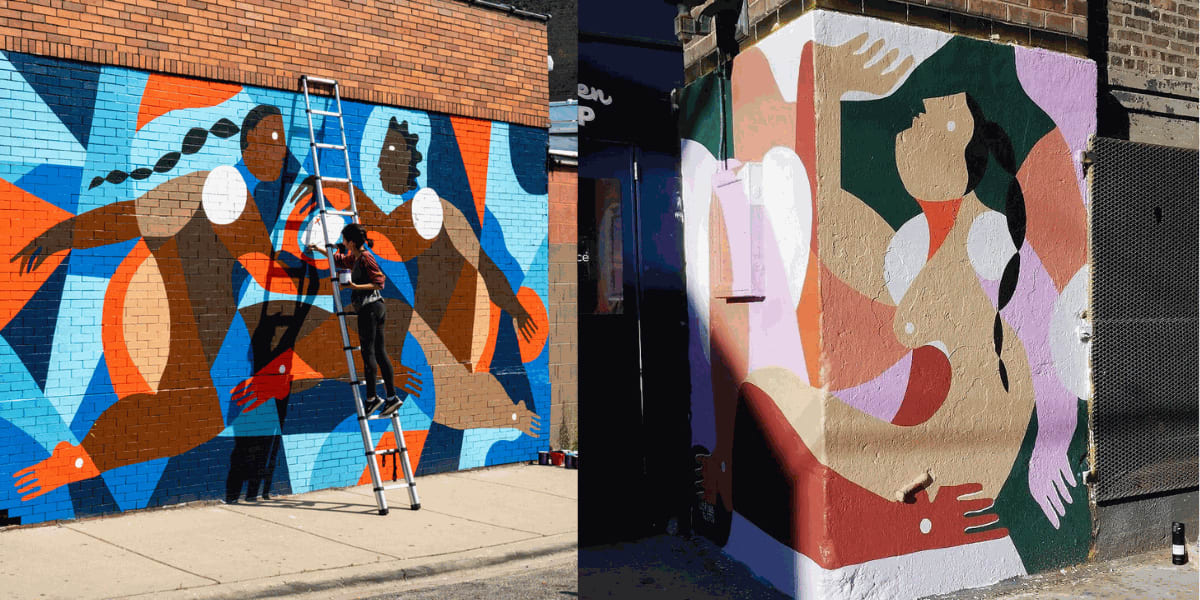
Liz Flores, a visionary artist of Mexican and Cuban descent, draws inspiration from the richness of everyday human experiences, the art of storytelling, and the captivating allure of the female form. Immersed in the world of acrylic paint on canvas, her artistic expression transcends conventional boundaries, encapsulating the essence of the human condition through a mesmerizing interplay of lines, shapes, and abstract figures.


DCG: There’s a striking absence of defined faces in your paintings. What is the significance of this choice, and how does it reflect your views on identity and self-perception?
LF: I’ve never been very interested in having my paintings necessarily look like me or have defined features. I want them to reflect thoughts and feelings and events that are important to me but I don't think they need to physically represent me to achieve this. What is more important is what these figures are doing or what is around them. Not having a defined face opens the painting to the viewer to hopefully be able to see themselves in the work as well. For me, it removes me a little from work, and allows me some space to be flexible.

DCG: Community and womanhood are potent themes within your art. How do you feel your heritage has shaped your representation of these concepts?
LF: Well I was raised by a whole community of women. Growing up it was not uncommon to spend a few months with my aunt and cousin, weekends with my grandmothers, and in general I had lots of strong female presence throughout my life. I think in the Latinx community a village is really at the heart of your upbringing. Mine had a lot of women in it and it has really shaped what is important to me and what I yearn to represent in my work.

DCG: The concept of Latinidad plays a vibrant role in your work. Can you speak to how this cultural narrative informs your artistic choices? And How this new series and title “asi es la vida” refer to your cultural roots and philosophy?
LF: As my work has developed it has naturally been drawn to colors, textures, and themes that I see woven throughout my upbringing as a Latina in the U.S. My color palette is rich in earth toned colors, and terra cotta hues that bring me back to the clay pottery and bowls that adorned our pantry. I see this even in how I decorate my apartment. I am just naturally drawn to these earth and jewel tones with pops of color.
Asi Es La Vida is a phrase my mother says. I especially remember it growing up. When she would be telling a story, talking about something negative happening in her world, she would end with ‘well asi es la vida’. This attitude is something of a strength because no matter what was happening it offered a form of resilience and acceptance of what was happening and allowed a path forward. It felt accurate to describe this new body of work that is exploring endings and beginnings in life.

LF: A typical painting session first begins with a pencil sketch. Sometimes in a sketchbook but I also like sketching on computer paper. It feels less precious and I find I am able to make mistakes and let loose more. I take any notes and ideas I’ve written down and bring them all out. These notes are often quotes from books, podcasts or audiobooks that I have listened to that have resonated deeply with an experience or feeling. I sometimes take photos of myself in different positions to try and get a composition correct. These always look really funny.
From there I like to take my sketches into my ipad and flush out the painting more playing with color until I finally feel ready to start painting. While I’m painting I’m working off the sketch I created on my ipad but I allow myself to play with color and change things where I feel necessary. I paint, take breaks, listen to podcasts and allow my hand to do what it needs to do.
It is a process that requires a lot of trust and dialogue with myself deciding where the next line goes.

DCG: Storytelling is a powerful element of your work. How do you see your viewers fitting into the stories that your paintings tell?
LF: Storytelling has become more and more important with my work as I have become more confident in my voice as a painter. I think many of the concepts, feelings and themes (such as loss, identity, friendship) come from a universal place that many viewers will hopefully be able to relate to.

DCG: Your choice of color seems very intentional. How do you decide on the color palette for a piece, and what role do you feel color plays in conveying the emotions of your work?
LF: Color is very important in my work. It guides the eyes, and helps tell the story. I once read an interview with Heather Day where she described color as a punctuation mark. That feels really true. Color can tell a story all on its own and depending on what I want to draw attention to or how I want the viewer to look at a painting, changes where the colors end up.
A recurring color in almost every painting i've made in the last few years is a version of mars yellow. I often begin with this color and build from here. If the painting feels more playful, I like to add pops of pink. Accentuating certain curvatures and shapes like the breast is often done with circular shapes and sometimes pops of red.

DCG: The interplay of lines and shapes in your art creates a sense of movement. How do you balance composition and spontaneity in your work? And in what way the modern cubism twist enhances your artistic message?
LF: I love when people talk about the sense of movement within the work because it’s something I am continuously working on - balancing the hard lines with the brushstrokes to create a better composition. I am not naturally a spontaneous person, which is why I think I am always working from a sketch. I like to have a plan but I have had to learn (and this is still a practice for me) to be ok with change even if that change might come at the very end of a painting's life.
Cubism gave me the ability to share feelings and messages that I felt I could not convey in other traditional painting forms. It gave me freedom and helped me open the door of spontaneity that is hard for me to access personally. In my work I’m not concerned with having anatomically correct bodies, and perspective. I think the cubist works in a way gave me permission to think this way.

DCG: As your brushstrokes weave a "visual symphony," is there a particular message or feeling you aim to impart upon your audience?
LF: The message really depends on the painting, but in general the brushstrokes and gestures within the work aim to give the painting more life. That is what I want my viewers to feel, I don’t just want it to be a graphic painting but something that feels like it has life within it.
DCG: Lastly, what do you hope your legacy as an artist will be, particularly in the context of contemporary Latinx art?
LF: I’m still trying to figure out my legacy. I try to take my career one day at a time, focusing on becoming a better painter and storyteller. I think this is the best thing I can do as a Latinx self taught artist trying to navigate the fine art world. I hope women and Latinx people can see themselves in my work and that at the end I made a small co ntribution to the contemporary Latinx art world that made the path easier for others.



